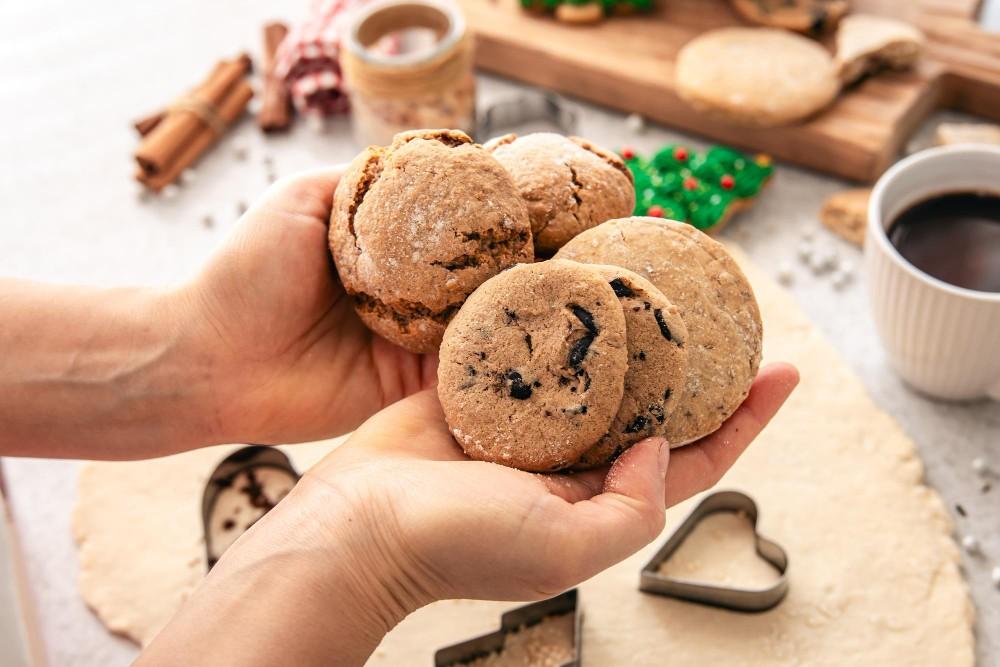Common Mistakes When Baking Cookies: Baking cookies is a beloved pastime for many, but even the most experienced bakers can make mistakes that affect the final result. In this comprehensive guide, we'll explore over 50 common mistakes encountered when baking cookies and how to avoid them. Whether you're a novice baker or a seasoned pro, this article will help you perfect your cookie-making skills.
What Makes a Good Cookie?
Before delving into the mistakes, let's briefly discuss what constitutes a good cookie. A perfect cookie should have a crisp edge, a chewy center, and a balanced flavor profile. Achieving this requires attention to detail and avoiding common pitfalls along the way.
11+ Common Mistakes When Baking Cookies
1: Not Preheating the Oven Properly
Symptoms and Signs
- Uneven baking
- Cookies spreading too much or not enough
- Inconsistent texture
Causes and Risk Factors
- Oven temperature not reaching the desired setting
- Rushing the preheating process
Diagnosis and Tests
- Use an oven thermometer to verify the actual temperature
- Preheat the oven for at least 10-15 minutes before baking
Treatment Options
- Allow sufficient time for the oven to reach the desired temperature
- Invest in a high-quality oven thermometer for accurate readings
Preventive Measures
- Always preheat the oven according to the recipe instructions
- Plan ahead to allow ample preheating time
2: Overmixing the Dough
Symptoms and Signs
- Tough, dense cookies
- Cookies that spread too much during baking
- Uneven texture
Causes and Risk Factors
- Excessive mixing of the dough, leading to gluten development
- Using a high-speed mixer instead of mixing by hand
Diagnosis and Tests
- Visual inspection of the dough texture before baking
- Baking a test batch to assess texture and consistency
Treatment Options
- Mix the dough until just combined to prevent gluten formation
- Consider hand mixing for better control over the process
Preventive Measures
- Follow the recipe instructions regarding mixing times
- Use a gentle folding motion when incorporating dry ingredients
3: Incorrectly Measuring Ingredients
Symptoms and Signs
- Inconsistent texture and flavor
- Dry or crumbly cookies
- Batter that's too thick or too thin
Causes and Risk Factors
- Eyeballing measurements instead of using precise measuring tools
- Using packed flour or sugar instead of properly leveled measurements
Diagnosis and Tests
- Weighing ingredients for accuracy
- Conducting a taste and texture test with properly measured ingredients
Treatment Options
- Invest in quality measuring tools, including a kitchen scale and measuring cups/spoons
- Practice proper measuring techniques, such as spooning flour into a measuring cup and leveling it off
Preventive Measures
- Always measure ingredients according to the recipe specifications
- Double-check measurements to ensure accuracy before adding to the dough
4: Ignoring Ingredient Temperature Requirements
Symptoms and Signs
- Inconsistent baking results
- Cookies that don't spread evenly
- Texture variations within the same batch
Causes and Risk Factors
- Using ingredients straight from the refrigerator instead of allowing them to come to room temperature
- Temperature discrepancies affecting the final dough consistency
Diagnosis and Tests
- Noting any temperature-related instructions in the recipe
- Observing the dough's texture and behavior during mixing
Treatment Options
- Plan ahead and take ingredients out of the refrigerator in advance to allow them to warm up
- Adjust mixing times or add additional liquid if necessary to compensate for cold ingredients
Preventive Measures
- Read the recipe carefully for any temperature-related instructions
- Allow refrigerated ingredients to sit at room temperature for the specified time before using
5: Using the Wrong Type of Flour
Symptoms and Signs
- Dense, heavy cookies
- Texture that's too chewy or too crumbly
- Lack of rise or spread during baking
Causes and Risk Factors
- Substituting one type of flour for another without considering the differences
- Not understanding the protein content and gluten-forming properties of different flours
Diagnosis and Tests
- Testing different types of flour in a small batch to observe the results
- Consulting baking experts or resources for guidance on flour selection
Treatment Options
- Use the type of flour specified in the recipe whenever possible
- Adjust the amount of liquid or leavening agents if using a different type of flour
Preventive Measures
- Stock a variety of flours in your pantry to accommodate different recipes
- Educate yourself on the characteristics of different flours and their suitable uses in baking
6: Overbaking or Underbaking the Cookies
Symptoms and Signs
- Burnt edges or bottoms
- Pale, undercooked centers
- Inconsistent texture throughout the batch
Causes and Risk Factors
- Not setting a timer or relying solely on visual cues to determine doneness
- Variations in oven temperature or cookie size affecting baking times
Diagnosis and Tests
- Conduct a visual inspection and texture test on a sacrificial cookie from each batch
- Use a timer to ensure consistent baking times for subsequent batches
Treatment Options
- Adjust baking times based on the specific characteristics of your oven and the size of your cookies
- Experiment with different baking times and temperatures to achieve the desired results
Preventive Measures
- Use a timer to track baking times accurately
- Monitor the cookies closely during the final minutes of baking to prevent overbrowning
7: Placing Cookie Dough on Warm Baking Sheets
Symptoms and Signs
- Excessive spreading of the cookies
- Uneven browning
- Difficulty removing cookies from the baking sheet without breakage
Causes and Risk Factors
- Placing dough on warm baking sheets can cause it to start spreading prematurely
- Elevated temperatures can lead to uneven baking and texture issues
Diagnosis and Tests
- Observing the behavior of the dough when placed on warm vs. room temperature baking sheets
- Baking test batches on both warm and cooled baking sheets to compare results
Treatment Options
- Allow baking sheets to cool completely between batches
- Use parchment paper or silicone baking mats to mitigate the effects of warm baking sheets
Preventive Measures
- Rotate multiple baking sheets if necessary to ensure they have time to cool between batches
- Plan ahead and prepare baking sheets in advance to avoid delays between batches
8: Not Allowing Cookies to Cool Properly Before Storage
Symptoms and Signs
- Moisture buildup inside storage containers
- Soggy or sticky cookies
- Loss of crispness or chewiness
Causes and Risk Factors
- Trapping residual heat and moisture inside storage containers can lead to condensation
- Storing warm cookies can cause them to become soft or lose their texture
Diagnosis and Tests
- Checking the cookies' texture and appearance after they've been stored for several hours
- Conducting a taste test to assess any changes in flavor or consistency
Treatment Options
- Allow cookies to cool completely on a wire rack before transferring them to storage containers. This allows excess moisture to evaporate and prevents condensation from forming inside the container.
Preventive Measures
- Patience is key; resist the temptation to store cookies while they're still warm.
- Use a wire rack to promote airflow around the cookies as they cool.
- Ensure cookies are completely cooled before sealing them in an airtight container.
9: Not Adjusting Altitude for High Altitude Baking
Symptoms and Signs
- Dry, crumbly texture
- Excessive spreading or rising during baking
- Inconsistent results compared to sea-level baking
Causes and Risk Factors
- Lower air pressure at higher altitudes affects baking conditions, leading to different outcomes
- Failure to adjust recipes for altitude can result in baking mishaps
Diagnosis and Tests
- Researching altitude adjustments for baking or consulting resources specific to your location
- Experimenting with adjustments to flour, leavening agents, and baking times
Treatment Options
- Increase the amount of flour or decrease the leavening agents to compensate for lower air pressure
- Extend baking times slightly to ensure thorough cooking at high altitudes
Preventive Measures
-
Research altitude-specific baking adjustments before attempting recipes
- Keep detailed notes of adjustments made and their effects for future reference
10: Using Expired or Stale Ingredients
Symptoms and Signs
- Off flavors or odors in the finished cookies
- Reduced leavening power in baking powder or baking soda
- Poor texture and consistency
Causes and Risk Factors
- Expired ingredients may lose their potency or develop off flavors
- Improper storage can lead to ingredient deterioration, even before the expiration date
Diagnosis and Tests
- Checking expiration dates on ingredients before use
- Conducting a taste and aroma test on questionable ingredients
Treatment Options
- Use fresh, high-quality ingredients to ensure optimal results
- Store ingredients properly in airtight containers in a cool, dry place
Preventive Measures
- Regularly check expiration dates on baking ingredients and replace as needed
- Keep ingredients properly sealed and stored to maintain freshness and potency
11: Skipping the Resting Period for Cookie Dough
Symptoms and Signs
- Cookies that spread excessively during baking
- Inconsistent texture and flavor
- Lack of complexity in flavor development
Causes and Risk Factors
- Allowing the dough to rest allows the flavors to meld and the gluten to relax, resulting in better texture and flavor
- Skipping this step can lead to subpar cookies with less depth of flavor and texture
Diagnosis and Tests
- Comparing cookies made with rested dough versus freshly mixed dough
- Conducting a taste test to assess flavor development and texture
Treatment Options
- Incorporate a resting period into your cookie-making process to allow the dough to hydrate and flavors to develop
- Experiment with different resting times to find the optimal balance between flavor development and convenience
Preventive Measures
- Plan ahead and allow sufficient time for the dough to rest before baking
- Incorporate the resting period into your baking schedule to ensure consistently delicious results
Conclusion
Baking perfect cookies requires attention to detail and an understanding of common mistakes to avoid. By following the tips and techniques outlined in this guide, you can elevate your cookie-making skills and impress friends and family with delicious treats every time. Remember to preheat your oven properly, measure ingredients accurately, and allow cookies to cool before storage. With practice and patience, you'll become a master cookie baker in no time! (Common Mistakes When Baking Cookies)


